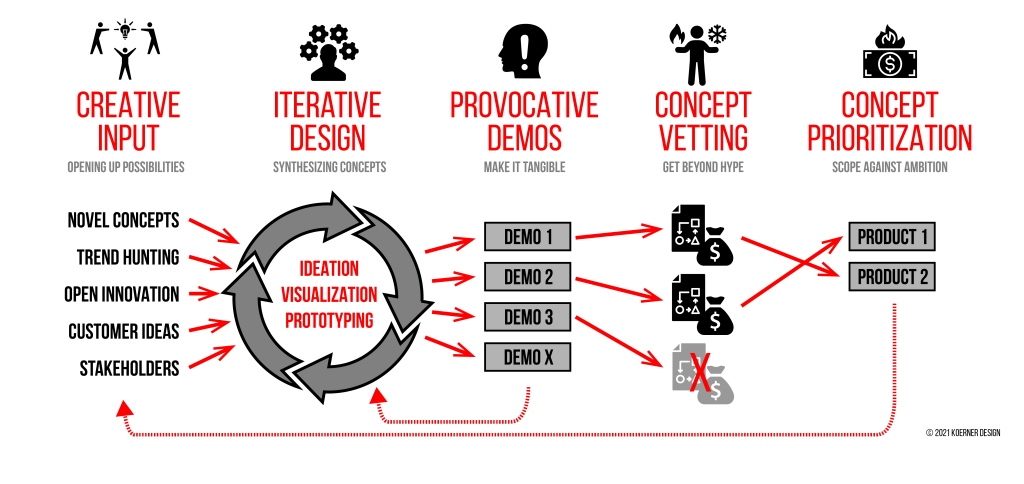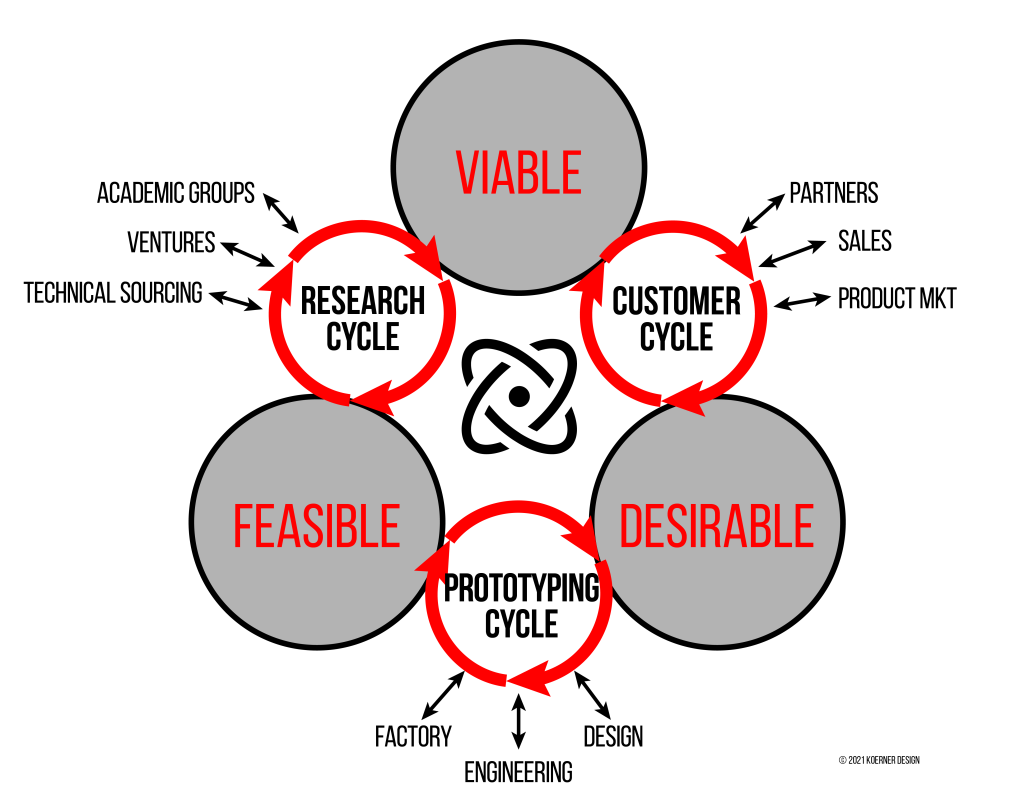Delivering new-to-the-world product concepts to market – the key value-add and reason-for-being for many organizations – is an elusive process to manage. The challenges of driving meaningful, profitable innovation programs are numerous. In particular, a paradox seems to exist where management teams value individual ideas greatly but grossly undervalue systematic processes for generating, vetting and prioritizing ideas.
There are 3 key concepts critical to successful innovation management: The Roadmapping Process; Continuous Innovation; and The Value of Lean/Agile/Design Thinking. Below are a collection of diagrams to help product managers, design leads or innovation managers visualize and explain the core process to their colleagues.
Click on each diagram if you want a larger view…
The Roadmapping Process
The first diagram covers the overall process of developing a proper roadmap, ranging from managing the collection, creation & curation of “good ideas”, to design exploration/prototyping, through to testing those ideas via provocative demos, to properly scoping and assigning a preliminary business case to each idea:

The end goal of a proper roadmapping process is a managed portfolio of development risk with a clear list of dev priorities. In general, “creatives” love the left side of the chart, while “managers” love the right. Many times managers think the front of the process is somehow wasteful, while creatives believe the end of the process destroys the vision. I think the real challenge is when either creatives OR managers naively believe the innovation process looks something like this:

The odds that one singular idea will somehow plow through all the challenges inherent in innovation to find a pot of gold at the other side are very, very low (and the business press conveniently likes to forgot how “hit products” usually went through tortured market births). The above diagram effectively represents someone’s “creative ego” – someone who is infatuated with a singular idea, but because they’ve never experienced formal design or innovation training, they don’t understand HOW to systematically create and compare multiple ideas.
This diagram from Charles Taylor is a good way to frame the core act of idea generation – opening up a breadth of possibilities that range from possible to plausible to probable to preferred.

Without a systematic process of idea generation, collection and curation, singular ideas get pushed through without the upfront exploration or evaluative checks needed to determine their relative worth. Then the product development process is simply riding the roller coaster of the classic hype cycle:

Continuous Innovation
The second diagram is my extension of IDEO’s popular Venn diagram about Design Thinking. In any truly innovative company, the core processes of customer research, technical research and prototyping/validation should be endless, continuous, cyclical functions:

The challenge with continuous innovation: Too many “business thinkers” don’t understand the continuous investment required to stay ahead of the competition; they think “innovation” is something you do once at some fun offsite brainstorming session with lots of post-it notes. They don’t understand the critical, ongoing value-generation coming from their Design or R&D teams, open innovation efforts and investing in prototyping. This seems especially true of business leaders who transfer from heavily commoditized categories into truly innovation-driven categories.
An easy to understand example of continuous innovation comes from the auto industry: Automakers invest in design to generate future concepts, then also invest in making flashy showcar prototypes which they put out in public to gauge reaction. They take that feedback and put it back into the actual roadmap prioritization and product development processes.
The Value of Lean/Agile/Design Thinking
The third and final diagram attempts to visualize why early stage prototyping, visualization and other “creative” functions deliver massive value to organizations – value that is often grossly underestimated by other process-driven, analytical functions like finance, supply chain, etc. I thought of this diagram as sort of a theorem-like setup:

In essence, I’m trying to diagram the paradox that while people value idea creation greatly, they discount the effort and investment required for idea curation (the process of prototyping, vetting & prioritizing those ideas), which largely determines if an idea will be successful or not.
So here’s the rub: Although 20% of the effort and resources will account for half of the market value (i.e. half the value is the correct idea, the other half is the idea delivered), the other 80% of the effort and resources is required to actually reach the market. Pareto’s principle rears its ugly head.
On the one hand, this is why so many Kickstarter programs fail – its very easy in today’s world to make beautiful working prototypes, but brutally difficult to bring finished goods to market. On the other hand, this is why so many big corporations squander their resources – they don’t sort out if ideas are valuable or not before pushing them all the way to market.
So that is why organizations need to deeply value their creative teams, product management teams, R&D groups, etc. and actively invest in the messy front-end process of pulling together ideas, threshing them out in prototypes, then being brutally honest when prioritizing development resources. Because if you screw up the front 20% of the process, the remaining 80% of a company’s functions are ultimately muda — the Japanese lean terminology for waste.
Conclusion
There is a tough balance between getting team members excited about the future while delivering on the expectations of the present. The ideal situation is to be spoiled with great ideas but fiercely rigorous about development priorities and resources. “Innovation” has become such an overused term that it has largely lost its real meaning, but at its essence it is not some foo-foo magic – from ideation through to warranty service, innovation can be very systematic, very process driven. The challenge is finding the precious few leaders that can bridge the gap between the creatives and the managers to ensure that real value ultimately flows to your customers.

More…
If you liked this post, you may also want to check out my other pieces “The Innovation Attitude Matrix” and “Marketing vs Product Marketing vs Sales Comms“.
About the Author

Brad Koerner is an innovation strategy and R&D program leader with a range of product development, design, marketing and corporate venture experience. Brad has launched new-to-the-world product categories that have earned in excess of $350m. Brad conceived, built and led a corporate venture at a Fortune 500 company, holds 20+ years’ experience spanning global matrix organizations, design consultancies & tech startups, and is an accomplished B2B speaker and writer exploring the future of experiential technologies.
